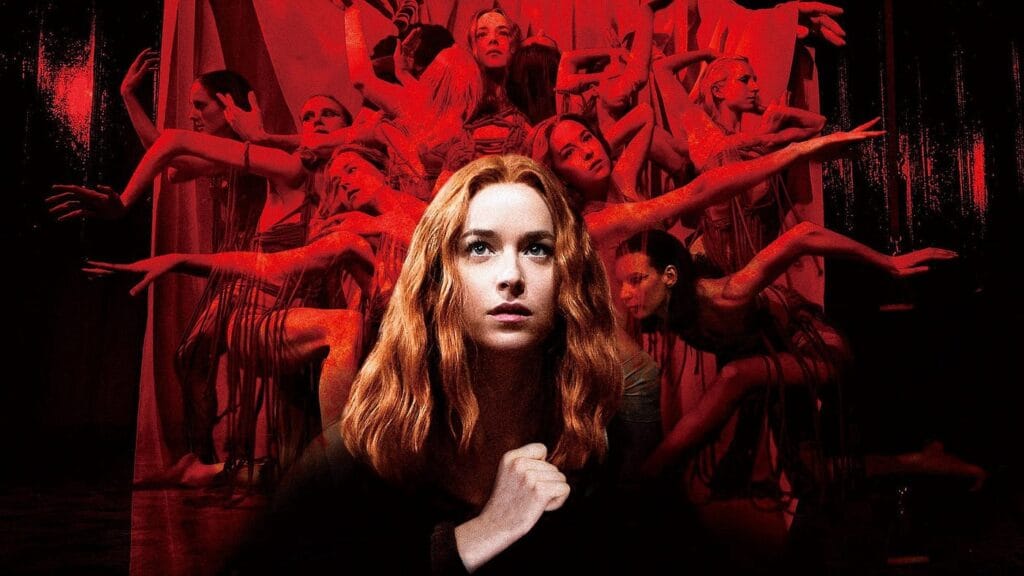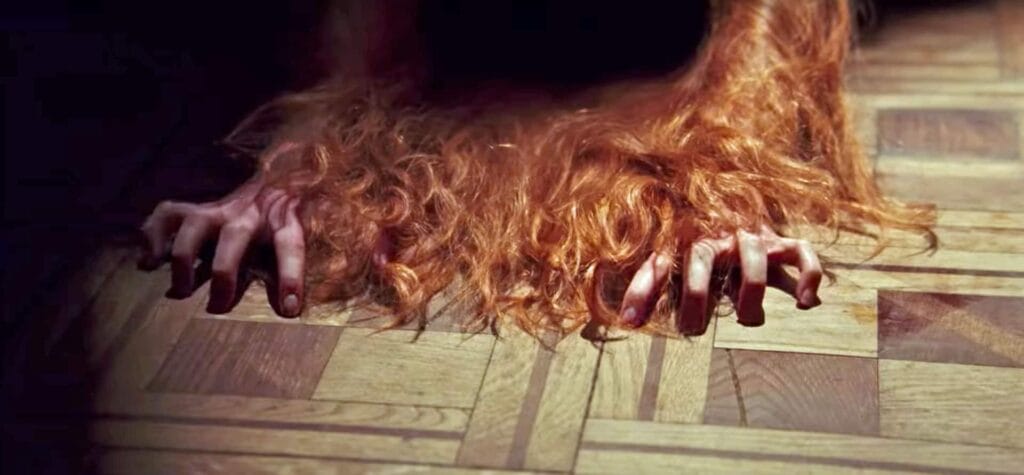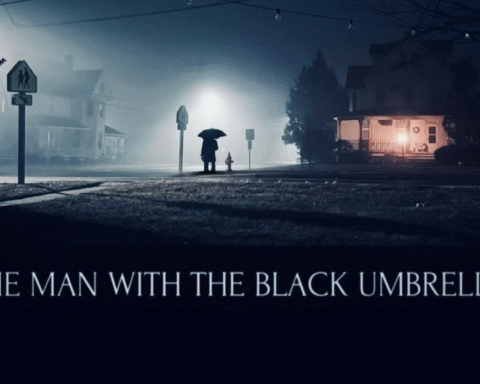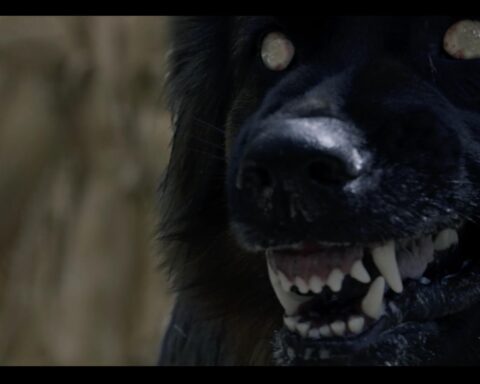Luca Guadagnino’s “Suspiria” (2018), a reimagining of Dario Argento’s 1977 classic, stands as a profound piece of cinematic art, weaving a complex tapestry of themes and philosophical undertones. The film, starring Dakota Johnson as Susie Bannion, transcends its horror genre roots to explore deeper existential and socio-political issues, wrapped in a dark, foreboding aesthetic. This analysis delves into the movie’s intricate narrative, symbolic motifs, and its philosophical and thematic resonance, while also drawing comparisons with Argento’s original to highlight the evolution of its storytelling and artistic vision.

Chapter 1: The Dance of Dualities
1.1. The Power of Movement
“Suspiria” is a film where dance serves as both a narrative device and a symbolic language. The Helena Markos Dance Company, under the eerie leadership of Madame Blanc (Tilda Swinton), becomes a microcosm for exploring themes of control, submission, and the primal force of movement. Dance in “Suspiria” is not merely an art form but a ritualistic performance, a conduit through which the characters express and confront their inner turmoils.
Susie Bannion’s transformation from a timid dancer to a powerful figure within the coven is mirrored through her evolving dance movements. The choreography is raw and visceral, reflecting the film’s dark and primal energy. It is through dance that the characters communicate with the supernatural, and it is dance that becomes the battleground for power and autonomy.
1.2. The Feminine Mystique
Guadagnino’s “Suspiria” delves deeply into the feminine mystique, presenting a cast predominantly composed of women whose relationships are layered with complexity and intensity. The witches’ coven is portrayed not just as a sinister force but as a collective embodying both nurturing and destructive tendencies. This duality underscores the film’s exploration of feminine power, autonomy, and solidarity.
Madame Blanc and Susie Bannion’s relationship evolves into a poignant dynamic, marked by mentorship, manipulation, and a profound understanding of each other’s strength. The coven’s internal politics and power struggles reflect broader themes of female agency and the often ambivalent nature of matriarchal structures.

Chapter 2: The Shadows of History
2.1. Post-War Trauma
Set against the backdrop of 1977 Berlin, “Suspiria” is imbued with the shadows of post-war trauma and the political unrest of its time. The divided city, scarred by its Nazi past and the ongoing Cold War, serves as a haunting metaphor for the fractured psyche of the characters and the tumultuous power dynamics within the dance company.
The film frequently references the Baader-Meinhof Group, a radical leftist faction active in Germany during the 1970s, drawing parallels between the revolutionary fervor outside and the radical transformation occurring within the dance academy. This historical context enriches the narrative, grounding the supernatural elements in a tangible reality fraught with tension and despair.
2.2. The Weight of Guilt
One of the film’s most poignant subplots involves Dr. Josef Klemperer (also portrayed by Tilda Swinton), a psychotherapist grappling with the guilt of his wife’s disappearance during the Holocaust. His interactions with the witches and his eventual entanglement in their dark rituals reflect a broader theme of historical guilt and the haunting presence of the past.
Klemperer’s character embodies the burden of memory and the struggle to reconcile with historical atrocities. His tragic arc serves as a counterpoint to the witches’ pursuit of renewal and power, highlighting the inescapable weight of guilt that permeates the film’s atmosphere.


Chapter 3: The Alchemy of Identity
3.1. Transformation and Rebirth
At its core, “Suspiria” is a tale of transformation and rebirth. Susie Bannion’s journey from an innocent newcomer to the embodiment of Mater Suspiriorum is a narrative steeped in alchemical symbolism. The dance academy serves as a crucible where identities are dissolved and reformed, mirroring the alchemical process of transmutation.
The film’s climactic ritual, where Susie embraces her true identity as the Mother of Sighs, is a moment of profound metamorphosis. This transformation is both a liberation and a binding, as Susie assumes her role within the coven, reshaping the power dynamics and ushering in a new era. The ritualistic elements and the visceral imagery evoke a sense of primal rebirth, a dark genesis that redefines the characters and their fates.
3.2. The Labyrinth of Self
The characters in “Suspiria” navigate a labyrinth of identity, confronting their deepest fears and desires. The dance academy becomes a psychological maze where boundaries between self and other, reality and illusion, blur. This labyrinthine structure reflects the film’s exploration of identity as a fluid, multifaceted construct.
Susie’s journey is marked by a gradual shedding of her previous self, a descent into the depths of her subconscious where she encounters both terror and revelation. The witches’ rituals and the academy’s oppressive atmosphere serve as catalysts for this introspective odyssey, compelling the characters to confront their true nature.


Chapter 4: The Symphony of Suffering
4.1. The Aesthetics of Horror
Guadagnino’s “Suspiria” is a masterclass in the aesthetics of horror. The film’s visual and auditory elements work in concert to create an atmosphere of dread and unease. The stark, almost clinical cinematography contrasts with the visceral, often grotesque imagery, evoking a sense of sublime horror.
The score, composed by Thom Yorke, adds another layer to the film’s eerie ambiance. The haunting melodies and dissonant tones mirror the characters’ psychological disarray, creating a symphony of suffering that resonates throughout the narrative. The interplay between sound and vision amplifies the film’s emotional impact, drawing the audience into its dark, immersive world.
4.2. Pain as a Pathway
In “Suspiria,” pain is portrayed as a transformative force, a pathway to deeper understanding and power. The dancers’ physical suffering and the witches’ brutal rituals underscore the film’s exploration of pain as an integral part of the human experience. This theme is reflected in the characters’ emotional and psychological struggles, as they grapple with their traumas and desires.
Susie’s embrace of pain, both physical and existential, becomes a pivotal aspect of her transformation. Her journey through suffering leads to a profound revelation, a deeper connection with her true self and her place within the coven. This portrayal of pain as a catalyst for growth and enlightenment adds a philosophical dimension to the film’s horror elements, elevating it beyond mere shock value.




Chapter 5: The Dance of Death and Renewal
5.1. Ritual and Sacrifice
Ritual and sacrifice are central to the narrative of “Suspiria,” serving as mechanisms for both destruction and creation. The witches’ coven relies on ancient rituals to maintain their power and influence, culminating in the climactic ceremony where Susie’s true identity is revealed. These rituals are imbued with a sense of inevitability, a dark choreography that dictates the characters’ fates.
The film’s depiction of sacrifice extends beyond the literal to encompass the broader theme of personal and collective transformation. The characters’ sacrifices, whether voluntary or coerced, become acts of renewal, forging new identities and altering the coven’s power dynamics. This cyclical interplay of death and rebirth is a testament to the film’s exploration of the eternal dance of creation and destruction.
5.2. The Cycle of Power
“Suspiria” presents power as a dynamic, ever-shifting force, subject to the whims of those who wield it and those who challenge it. The coven’s internal power struggles reflect the broader societal tensions of the time, highlighting the fragility and volatility of authority. Susie’s ascension disrupts the established order, heralding a new era marked by both hope and uncertainty.
The film’s ending, where Susie spares Klemperer and offers him a measure of peace, suggests a nuanced view of power. It is not merely a tool for domination but also a means of reconciliation and healing. This multifaceted portrayal of power adds depth to the narrative, emphasizing the complexities of human relationships and the perpetual cycle of ascent and decline.


Chapter 6: The Haunted Legacy
6.1. Echoes of Argento
Comparing Guadagnino’s “Suspiria” to Dario Argento’s original reveals a fascinating evolution in both narrative and style. While Argento’s film is renowned for its vibrant, surreal aesthetic and pioneering use of color and sound, Guadagnino’s reimagining opts for a more subdued, somber palette and a deeper exploration of psychological and philosophical themes.
Argento’s “Suspiria” is a visceral, sensory experience, emphasizing visual spectacle and primal horror. Guadagnino, however, infuses his version with a rich historical and emotional context, grounding the supernatural elements in a tangible reality. This shift in focus reflects a broader change in cinematic storytelling, from the overtly fantastical to the introspective and existential.
6.2. The Evolution of Horror
The evolution from Argento’s “Suspiria” to Guadagnino’s reimagining mirrors the broader transformation of the horror genre. Argento’s film, with its bold visual style and emphasis on shock and awe, epitomizes the aesthetic of 1970s horror, where spectacle and sensory overload were paramount. Guadagnino’s approach, in contrast, reflects a modern sensibility that prioritizes character development, thematic depth, and psychological realism.
This shift highlights the changing audience expectations and the genre’s capacity for reinvention. Guadagnino’s “Suspiria” stands as a testament to the enduring appeal of horror, demonstrating its potential to explore complex ideas and emotions while still delivering the visceral thrills that define the genre.

A Dark Tapestry
Luca Guadagnino’s “Suspiria” is a dark, intricate tapestry woven from threads of history, identity, and primal horror. Its exploration of dualities, transformation, and the human capacity for both suffering and renewal elevates it beyond a mere horror film to a profound meditation on the human condition. By reimagining Argento’s classic through a modern, introspective lens, Guadagnino has created a work that resonates with both the fears and hopes of contemporary audiences, a haunting symphony of sight and sound that lingers long after the final frame.









